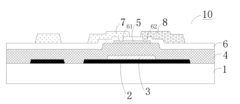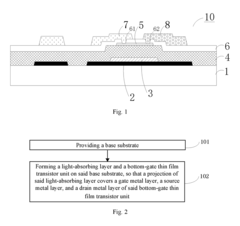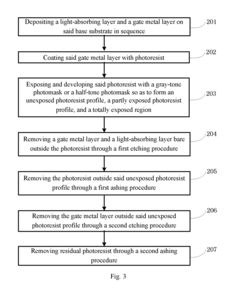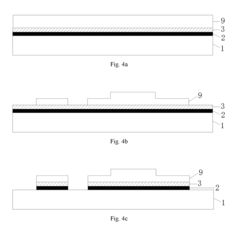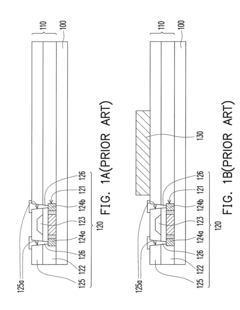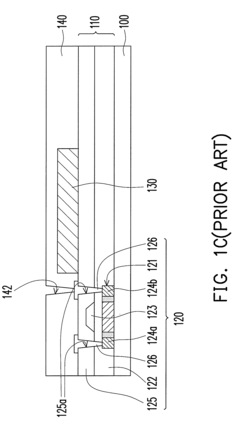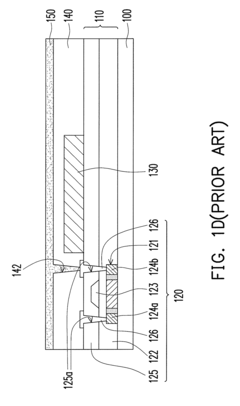Improvements in anti-reflective coatings for AMOLED.
JUL 17, 20259 MIN READ
Generate Your Research Report Instantly with AI Agent
Patsnap Eureka helps you evaluate technical feasibility & market potential.
AMOLED AR Coating Evolution
The evolution of anti-reflective (AR) coatings for AMOLED displays has been a critical factor in enhancing display performance and user experience. Initially, AMOLED displays suffered from high reflectivity, which compromised visibility in bright environments and reduced overall image quality. The development of AR coatings has been driven by the need to address these issues and improve display readability across various lighting conditions.
In the early stages of AMOLED technology, basic single-layer AR coatings were employed. These coatings, typically made of materials like silicon dioxide or magnesium fluoride, provided a modest reduction in reflectivity. However, they were limited in their effectiveness across the visible spectrum and often resulted in color distortion.
As AMOLED displays gained popularity, multi-layer AR coatings emerged as a significant improvement. These coatings consisted of alternating layers of high and low refractive index materials, designed to create destructive interference for a broader range of wavelengths. This approach dramatically reduced reflectivity across the visible spectrum, leading to improved contrast and color accuracy.
The next major advancement came with the introduction of nano-structured AR coatings. These coatings utilized precisely engineered nanostructures to gradually change the refractive index from air to the display surface. This gradual transition minimized abrupt changes in refractive index, resulting in superior anti-reflective properties and reduced glare.
Recent years have seen the development of hybrid AR coatings that combine multiple technologies. These coatings often integrate nano-structured layers with traditional multi-layer designs, offering the benefits of both approaches. Additionally, some hybrid coatings incorporate hydrophobic and oleophobic properties, making them resistant to fingerprints and easier to clean.
The latest frontier in AR coating technology for AMOLED displays involves the use of advanced materials and deposition techniques. Researchers are exploring the potential of materials like graphene and other 2D materials to create ultra-thin, highly effective AR coatings. These materials offer the promise of exceptional optical properties while maintaining the flexibility required for foldable and rollable AMOLED displays.
Furthermore, advancements in deposition techniques, such as atomic layer deposition (ALD) and plasma-enhanced chemical vapor deposition (PECVD), have enabled the creation of more precise and uniform AR coatings. These techniques allow for better control over layer thickness and composition, resulting in coatings with superior optical performance and durability.
In the early stages of AMOLED technology, basic single-layer AR coatings were employed. These coatings, typically made of materials like silicon dioxide or magnesium fluoride, provided a modest reduction in reflectivity. However, they were limited in their effectiveness across the visible spectrum and often resulted in color distortion.
As AMOLED displays gained popularity, multi-layer AR coatings emerged as a significant improvement. These coatings consisted of alternating layers of high and low refractive index materials, designed to create destructive interference for a broader range of wavelengths. This approach dramatically reduced reflectivity across the visible spectrum, leading to improved contrast and color accuracy.
The next major advancement came with the introduction of nano-structured AR coatings. These coatings utilized precisely engineered nanostructures to gradually change the refractive index from air to the display surface. This gradual transition minimized abrupt changes in refractive index, resulting in superior anti-reflective properties and reduced glare.
Recent years have seen the development of hybrid AR coatings that combine multiple technologies. These coatings often integrate nano-structured layers with traditional multi-layer designs, offering the benefits of both approaches. Additionally, some hybrid coatings incorporate hydrophobic and oleophobic properties, making them resistant to fingerprints and easier to clean.
The latest frontier in AR coating technology for AMOLED displays involves the use of advanced materials and deposition techniques. Researchers are exploring the potential of materials like graphene and other 2D materials to create ultra-thin, highly effective AR coatings. These materials offer the promise of exceptional optical properties while maintaining the flexibility required for foldable and rollable AMOLED displays.
Furthermore, advancements in deposition techniques, such as atomic layer deposition (ALD) and plasma-enhanced chemical vapor deposition (PECVD), have enabled the creation of more precise and uniform AR coatings. These techniques allow for better control over layer thickness and composition, resulting in coatings with superior optical performance and durability.
Market Demand Analysis
The market demand for improvements in anti-reflective coatings for AMOLED displays has been steadily increasing, driven by the growing adoption of AMOLED technology in various consumer electronics. As AMOLED displays become more prevalent in smartphones, tablets, smartwatches, and televisions, manufacturers are seeking enhanced anti-reflective solutions to improve display visibility and user experience.
One of the primary factors fueling this demand is the consumer preference for devices with better outdoor visibility and reduced eye strain. Anti-reflective coatings play a crucial role in minimizing glare and reflections, especially in bright environments, which directly impacts the perceived quality of the display. As consumers become more discerning about display quality, the demand for advanced anti-reflective coatings has become a key differentiator in the competitive electronics market.
The automotive industry has also emerged as a significant driver for improved anti-reflective coatings in AMOLED displays. With the increasing integration of digital dashboards and infotainment systems in vehicles, there is a growing need for displays that maintain visibility under various lighting conditions, including direct sunlight. This has led to a surge in demand for high-performance anti-reflective solutions specifically tailored for automotive applications.
In the wearable technology sector, particularly smartwatches and fitness trackers, the demand for anti-reflective coatings has seen substantial growth. These devices often rely on AMOLED displays for their compact form factor and energy efficiency. However, their small screen size makes them particularly susceptible to readability issues caused by reflections, driving the need for advanced anti-reflective technologies.
The healthcare and medical device industry has also contributed to the increasing market demand for improved anti-reflective coatings. AMOLED displays are being increasingly used in medical imaging equipment, patient monitoring systems, and portable diagnostic devices. In these applications, display clarity and accuracy are paramount, necessitating high-performance anti-reflective solutions that can ensure optimal visibility in various clinical environments.
From a geographical perspective, the demand for advanced anti-reflective coatings is particularly strong in regions with high smartphone and consumer electronics penetration, such as North America, Europe, and East Asia. Emerging markets in Southeast Asia and India are also showing rapid growth in demand as AMOLED technology becomes more accessible in these regions.
The market trend indicates a shift towards multi-functional coatings that not only provide anti-reflective properties but also offer additional benefits such as scratch resistance, fingerprint resistance, and self-cleaning capabilities. This trend is driven by the desire to enhance overall device durability and user experience, further expanding the potential market for advanced coating technologies.
One of the primary factors fueling this demand is the consumer preference for devices with better outdoor visibility and reduced eye strain. Anti-reflective coatings play a crucial role in minimizing glare and reflections, especially in bright environments, which directly impacts the perceived quality of the display. As consumers become more discerning about display quality, the demand for advanced anti-reflective coatings has become a key differentiator in the competitive electronics market.
The automotive industry has also emerged as a significant driver for improved anti-reflective coatings in AMOLED displays. With the increasing integration of digital dashboards and infotainment systems in vehicles, there is a growing need for displays that maintain visibility under various lighting conditions, including direct sunlight. This has led to a surge in demand for high-performance anti-reflective solutions specifically tailored for automotive applications.
In the wearable technology sector, particularly smartwatches and fitness trackers, the demand for anti-reflective coatings has seen substantial growth. These devices often rely on AMOLED displays for their compact form factor and energy efficiency. However, their small screen size makes them particularly susceptible to readability issues caused by reflections, driving the need for advanced anti-reflective technologies.
The healthcare and medical device industry has also contributed to the increasing market demand for improved anti-reflective coatings. AMOLED displays are being increasingly used in medical imaging equipment, patient monitoring systems, and portable diagnostic devices. In these applications, display clarity and accuracy are paramount, necessitating high-performance anti-reflective solutions that can ensure optimal visibility in various clinical environments.
From a geographical perspective, the demand for advanced anti-reflective coatings is particularly strong in regions with high smartphone and consumer electronics penetration, such as North America, Europe, and East Asia. Emerging markets in Southeast Asia and India are also showing rapid growth in demand as AMOLED technology becomes more accessible in these regions.
The market trend indicates a shift towards multi-functional coatings that not only provide anti-reflective properties but also offer additional benefits such as scratch resistance, fingerprint resistance, and self-cleaning capabilities. This trend is driven by the desire to enhance overall device durability and user experience, further expanding the potential market for advanced coating technologies.
Current AR Tech Challenges
Anti-reflective (AR) coatings for AMOLED displays face several significant challenges in their current technological state. One of the primary issues is achieving optimal balance between reflection reduction and light transmission. While AR coatings effectively minimize reflections, they can also reduce the amount of light emitted from the display, potentially compromising brightness and color accuracy.
Another challenge lies in the durability and longevity of AR coatings. AMOLED displays are often used in mobile devices, which are subject to frequent handling and environmental stresses. Current AR coatings may degrade over time due to scratches, abrasions, and exposure to various elements, leading to reduced effectiveness and potential visual impairments.
The complexity of AMOLED display structures poses additional difficulties for AR coating application. The multi-layer nature of these displays, combined with the presence of organic materials, requires careful consideration in coating design and application methods to ensure compatibility and avoid damage to the underlying display components.
Uniformity in coating thickness and refractive index across the entire display surface remains a persistent challenge. Variations in these parameters can lead to inconsistent anti-reflective performance, resulting in visible artifacts or "hot spots" on the display. Achieving uniform coatings on large-area displays or curved surfaces further compounds this issue.
Cost-effectiveness and scalability of AR coating technologies for mass production present ongoing hurdles. Current high-performance AR coatings often involve complex deposition processes or expensive materials, making them less economically viable for widespread adoption in consumer electronics.
The environmental impact of AR coating materials and processes is an emerging concern. Many traditional coating materials and deposition methods may not align with increasing demands for sustainability and eco-friendliness in manufacturing processes.
Lastly, the development of AR coatings that can effectively manage a wide spectrum of light, including both visible and near-infrared wavelengths, remains a significant technical challenge. This is particularly important for AMOLED displays integrated with under-display sensors or cameras, where the coating must not interfere with the functionality of these components while still providing effective anti-reflective properties.
Another challenge lies in the durability and longevity of AR coatings. AMOLED displays are often used in mobile devices, which are subject to frequent handling and environmental stresses. Current AR coatings may degrade over time due to scratches, abrasions, and exposure to various elements, leading to reduced effectiveness and potential visual impairments.
The complexity of AMOLED display structures poses additional difficulties for AR coating application. The multi-layer nature of these displays, combined with the presence of organic materials, requires careful consideration in coating design and application methods to ensure compatibility and avoid damage to the underlying display components.
Uniformity in coating thickness and refractive index across the entire display surface remains a persistent challenge. Variations in these parameters can lead to inconsistent anti-reflective performance, resulting in visible artifacts or "hot spots" on the display. Achieving uniform coatings on large-area displays or curved surfaces further compounds this issue.
Cost-effectiveness and scalability of AR coating technologies for mass production present ongoing hurdles. Current high-performance AR coatings often involve complex deposition processes or expensive materials, making them less economically viable for widespread adoption in consumer electronics.
The environmental impact of AR coating materials and processes is an emerging concern. Many traditional coating materials and deposition methods may not align with increasing demands for sustainability and eco-friendliness in manufacturing processes.
Lastly, the development of AR coatings that can effectively manage a wide spectrum of light, including both visible and near-infrared wavelengths, remains a significant technical challenge. This is particularly important for AMOLED displays integrated with under-display sensors or cameras, where the coating must not interfere with the functionality of these components while still providing effective anti-reflective properties.
Existing AR Solutions
01 Multilayer anti-reflective coatings
Multilayer anti-reflective coatings are designed to reduce reflectivity by using alternating layers of materials with different refractive indices. These coatings typically consist of high and low refractive index materials stacked in a specific order to create destructive interference of reflected light, thereby minimizing reflectivity across a broad spectrum of wavelengths.- Multilayer anti-reflective coatings: Multilayer anti-reflective coatings are designed to reduce reflectivity by using alternating layers of materials with different refractive indices. These coatings typically consist of high and low refractive index materials, such as metal oxides, deposited in specific thicknesses to create destructive interference of reflected light, thereby minimizing reflectivity across a broad spectrum of wavelengths.
- Nanostructured anti-reflective surfaces: Nanostructured anti-reflective surfaces utilize sub-wavelength features to gradually change the refractive index from air to the substrate material. These structures can be created through various methods, such as etching or nanoimprinting, and can achieve extremely low reflectivity across a wide range of angles and wavelengths. The nanostructures effectively eliminate the abrupt change in refractive index that causes reflection.
- Graded-index anti-reflective coatings: Graded-index anti-reflective coatings feature a gradual change in refractive index from the air to the substrate. This can be achieved through various deposition techniques or by creating porous structures with varying densities. The gradual change in refractive index minimizes reflection by eliminating sharp interfaces between materials with different optical properties.
- Moth-eye inspired anti-reflective structures: Inspired by the eyes of nocturnal moths, these anti-reflective structures consist of arrays of conical or pyramidal protrusions on the surface. These structures create a gradual transition in refractive index, effectively reducing reflection across a wide range of wavelengths and incident angles. The moth-eye structure can be fabricated using various techniques, including lithography and etching processes.
- Anti-reflective coatings for photolithography: Specialized anti-reflective coatings are used in photolithography processes to minimize reflection and improve pattern resolution. These coatings are typically applied beneath the photoresist layer and are designed to absorb light that passes through the photoresist, preventing it from reflecting back and causing unwanted exposure. The coatings may include light-absorbing dyes or other materials tailored to specific wavelengths used in lithography.
02 Nanostructured anti-reflective surfaces
Nanostructured anti-reflective surfaces utilize sub-wavelength structures to gradually change the refractive index from air to the substrate material. These structures can be fabricated using various techniques such as etching or deposition processes, resulting in a surface that effectively reduces reflectivity by minimizing the abrupt change in refractive index at the interface.Expand Specific Solutions03 Graded-index anti-reflective coatings
Graded-index anti-reflective coatings feature a gradual change in refractive index from the air to the substrate. This approach minimizes reflections by creating a smooth transition between different refractive indices, effectively reducing the overall reflectivity of the surface. These coatings can be achieved through various deposition techniques or by creating porous structures with varying densities.Expand Specific Solutions04 Moth-eye inspired anti-reflective structures
Inspired by the eyes of nocturnal moths, these anti-reflective structures consist of arrays of nanoscale protrusions that effectively reduce reflectivity. The structures work by creating a gradual transition in refractive index, similar to graded-index coatings, but achieve this through physical surface texturing rather than material composition changes. These biomimetic designs can be applied to various substrates to enhance their anti-reflective properties.Expand Specific Solutions05 Plasma-enhanced chemical vapor deposition (PECVD) for anti-reflective coatings
PECVD is a technique used to deposit thin films of anti-reflective materials on various substrates. This method allows for precise control over the composition and thickness of the deposited layers, enabling the creation of highly effective anti-reflective coatings. PECVD can be used to deposit both single-layer and multilayer anti-reflective coatings with tailored optical properties to minimize reflectivity.Expand Specific Solutions
Key AMOLED AR Players
The anti-reflective coating market for AMOLED displays is in a growth phase, driven by increasing demand for high-quality displays in smartphones, TVs, and other electronic devices. The market size is expanding rapidly, with major players like Merck, Corning, and LG Chem investing heavily in R&D. Technological advancements are focused on improving coating efficiency, durability, and optical performance. Companies such as Brewer Science and Nissan Chemical are developing innovative materials, while display manufacturers like Japan Display and TCL China Star Optoelectronics are integrating these coatings into their production processes. The competition is intense, with both established chemical companies and specialized coating firms vying for market share in this high-potential segment.
Merck Patent GmbH
Technical Solution: Merck has developed advanced anti-reflective coatings for AMOLED displays using nanostructured materials. Their technology involves creating a multi-layer coating with precisely controlled refractive indices and thicknesses. The coating includes a high-refractive index layer composed of titanium dioxide nanoparticles and a low-refractive index layer made of silica nanoparticles[1]. This structure effectively reduces reflections across a wide range of wavelengths. Merck's coating also incorporates fluoropolymers to enhance durability and scratch resistance[3]. The company has further improved the coating's performance by implementing a gradient refractive index design, which provides a smoother transition between the air and display surface[5].
Strengths: Excellent anti-reflective properties, wide spectral range coverage, enhanced durability. Weaknesses: Potentially higher production costs due to complex nanostructure, may require specialized application equipment.
Corning, Inc.
Technical Solution: Corning has innovated in AMOLED anti-reflective coatings with their proprietary Gorilla Glass technology. They have developed an ultra-thin, high-refractive index coating that is directly integrated into the glass manufacturing process. This coating utilizes a sol-gel deposition method to create a nanoporous structure with controlled pore size and distribution[2]. The result is a coating that not only reduces reflections but also enhances the overall durability of the display. Corning's latest iteration incorporates ion-exchange technology to further improve scratch resistance and impact strength[4]. Additionally, they have implemented a multi-layer design that optimizes light transmission while maintaining excellent anti-reflective properties across the visible spectrum[6].
Strengths: Integrated manufacturing process, excellent durability, optimized for mobile devices. Weaknesses: May be more expensive than traditional coatings, potentially limited to Corning's glass products.
Core AR Coating Patents
Array substrate, display device, and method for manufacturing array substrate
PatentActiveUS20170148862A1
Innovation
- An array substrate with a light-absorbing layer covering the gate, source, and drain metal layers of a bottom-gate thin film transistor unit, preventing ambient light irradiation while allowing useful light to pass through.
Active matrix organic light emitting diode display device and structure of such device
PatentInactiveUS20090033217A1
Innovation
- A method using a half-tone mask to pattern color photoresistant layers, which simplifies the process by eliminating the need for pixel defining layers and etching masks, allowing the color filter layers to function as both filters and masks for creating contact window openings, thereby reducing production costs and complexity.
Environmental Impact
The environmental impact of improvements in anti-reflective coatings for AMOLED displays is a crucial consideration in the development and adoption of this technology. These coatings play a significant role in enhancing display performance, but their production and disposal can have substantial environmental implications.
The manufacturing process of anti-reflective coatings often involves the use of various chemicals and materials, some of which may be hazardous or resource-intensive. As improvements are made to these coatings, there is a growing emphasis on developing more environmentally friendly production methods and materials. This includes the exploration of bio-based alternatives and the implementation of cleaner production techniques to reduce the environmental footprint of coating manufacturing.
Energy consumption during the production of anti-reflective coatings is another important factor to consider. Advanced coating technologies may require more sophisticated equipment and processes, potentially leading to increased energy usage. However, ongoing research aims to optimize these processes, focusing on energy-efficient methods and the integration of renewable energy sources in production facilities.
The durability and lifespan of anti-reflective coatings directly impact the overall environmental sustainability of AMOLED displays. Improved coatings that offer better scratch resistance and longevity can significantly reduce the need for device replacements or repairs, thereby minimizing electronic waste. This aspect is particularly important given the growing concern over e-waste and its environmental consequences.
End-of-life considerations for AMOLED displays with advanced anti-reflective coatings are also crucial. The recyclability and biodegradability of these coatings are becoming increasingly important factors in their development. Researchers are exploring ways to create coatings that can be easily separated from the display components during recycling processes, facilitating more efficient material recovery and reducing the environmental impact of disposal.
The potential for reduced power consumption in AMOLED displays due to improved anti-reflective coatings is a positive environmental aspect. By enhancing display visibility and reducing the need for high brightness settings, these coatings can contribute to extended battery life and lower energy consumption over the device's lifetime. This indirect environmental benefit can be significant when considering the large-scale adoption of AMOLED technology in various electronic devices.
As the demand for AMOLED displays continues to grow, the environmental impact of their production, including anti-reflective coatings, becomes increasingly important. Industry stakeholders are recognizing the need for sustainable practices and are investing in research and development to minimize negative environmental effects while maximizing performance improvements. This holistic approach to technology development is essential for ensuring that advancements in anti-reflective coatings contribute positively to both display quality and environmental sustainability.
The manufacturing process of anti-reflective coatings often involves the use of various chemicals and materials, some of which may be hazardous or resource-intensive. As improvements are made to these coatings, there is a growing emphasis on developing more environmentally friendly production methods and materials. This includes the exploration of bio-based alternatives and the implementation of cleaner production techniques to reduce the environmental footprint of coating manufacturing.
Energy consumption during the production of anti-reflective coatings is another important factor to consider. Advanced coating technologies may require more sophisticated equipment and processes, potentially leading to increased energy usage. However, ongoing research aims to optimize these processes, focusing on energy-efficient methods and the integration of renewable energy sources in production facilities.
The durability and lifespan of anti-reflective coatings directly impact the overall environmental sustainability of AMOLED displays. Improved coatings that offer better scratch resistance and longevity can significantly reduce the need for device replacements or repairs, thereby minimizing electronic waste. This aspect is particularly important given the growing concern over e-waste and its environmental consequences.
End-of-life considerations for AMOLED displays with advanced anti-reflective coatings are also crucial. The recyclability and biodegradability of these coatings are becoming increasingly important factors in their development. Researchers are exploring ways to create coatings that can be easily separated from the display components during recycling processes, facilitating more efficient material recovery and reducing the environmental impact of disposal.
The potential for reduced power consumption in AMOLED displays due to improved anti-reflective coatings is a positive environmental aspect. By enhancing display visibility and reducing the need for high brightness settings, these coatings can contribute to extended battery life and lower energy consumption over the device's lifetime. This indirect environmental benefit can be significant when considering the large-scale adoption of AMOLED technology in various electronic devices.
As the demand for AMOLED displays continues to grow, the environmental impact of their production, including anti-reflective coatings, becomes increasingly important. Industry stakeholders are recognizing the need for sustainable practices and are investing in research and development to minimize negative environmental effects while maximizing performance improvements. This holistic approach to technology development is essential for ensuring that advancements in anti-reflective coatings contribute positively to both display quality and environmental sustainability.
Cost-Benefit Analysis
The implementation of anti-reflective coatings for AMOLED displays involves a careful consideration of costs and benefits. The primary cost factors include materials, manufacturing processes, and potential yield losses during production. High-quality anti-reflective materials, such as multi-layer dielectric coatings or nanostructured surfaces, can be expensive to source and apply. The manufacturing process may require specialized equipment and clean room environments, adding to the overall production costs.
However, these costs must be weighed against the significant benefits that anti-reflective coatings provide. Improved display visibility, especially in high-ambient light conditions, enhances user experience and device usability. This can lead to increased consumer satisfaction and potentially higher sales volumes. The reduction in reflections also contributes to better color accuracy and contrast, which are critical factors in display quality perception.
From an energy efficiency perspective, anti-reflective coatings can reduce the need for higher display brightness settings, potentially extending battery life in mobile devices. This improvement in power consumption can be a significant selling point and may justify the additional production costs.
Long-term durability of the coating is another important consideration. While high-quality anti-reflective coatings may increase initial costs, their ability to maintain performance over the device's lifetime can reduce warranty claims and improve brand reputation. This factor should be included in the overall cost-benefit analysis.
Market positioning is also crucial. Premium devices with superior display quality can command higher prices, potentially offsetting the increased production costs. In competitive markets, the improved display performance could be a key differentiator, justifying the investment in advanced anti-reflective technologies.
It's important to consider the scalability of the chosen anti-reflective solution. As production volumes increase, economies of scale may reduce per-unit costs, improving the cost-benefit ratio over time. Additionally, advancements in coating technologies and manufacturing processes may lead to more cost-effective solutions in the future, further enhancing the long-term benefits.
In conclusion, while the implementation of advanced anti-reflective coatings for AMOLED displays does incur significant upfront costs, the benefits in terms of display quality, user experience, and potential market advantages often outweigh these expenses. A thorough analysis of both short-term costs and long-term benefits is essential for making informed decisions about investing in these technologies.
However, these costs must be weighed against the significant benefits that anti-reflective coatings provide. Improved display visibility, especially in high-ambient light conditions, enhances user experience and device usability. This can lead to increased consumer satisfaction and potentially higher sales volumes. The reduction in reflections also contributes to better color accuracy and contrast, which are critical factors in display quality perception.
From an energy efficiency perspective, anti-reflective coatings can reduce the need for higher display brightness settings, potentially extending battery life in mobile devices. This improvement in power consumption can be a significant selling point and may justify the additional production costs.
Long-term durability of the coating is another important consideration. While high-quality anti-reflective coatings may increase initial costs, their ability to maintain performance over the device's lifetime can reduce warranty claims and improve brand reputation. This factor should be included in the overall cost-benefit analysis.
Market positioning is also crucial. Premium devices with superior display quality can command higher prices, potentially offsetting the increased production costs. In competitive markets, the improved display performance could be a key differentiator, justifying the investment in advanced anti-reflective technologies.
It's important to consider the scalability of the chosen anti-reflective solution. As production volumes increase, economies of scale may reduce per-unit costs, improving the cost-benefit ratio over time. Additionally, advancements in coating technologies and manufacturing processes may lead to more cost-effective solutions in the future, further enhancing the long-term benefits.
In conclusion, while the implementation of advanced anti-reflective coatings for AMOLED displays does incur significant upfront costs, the benefits in terms of display quality, user experience, and potential market advantages often outweigh these expenses. A thorough analysis of both short-term costs and long-term benefits is essential for making informed decisions about investing in these technologies.
Unlock deeper insights with Patsnap Eureka Quick Research — get a full tech report to explore trends and direct your research. Try now!
Generate Your Research Report Instantly with AI Agent
Supercharge your innovation with Patsnap Eureka AI Agent Platform!
